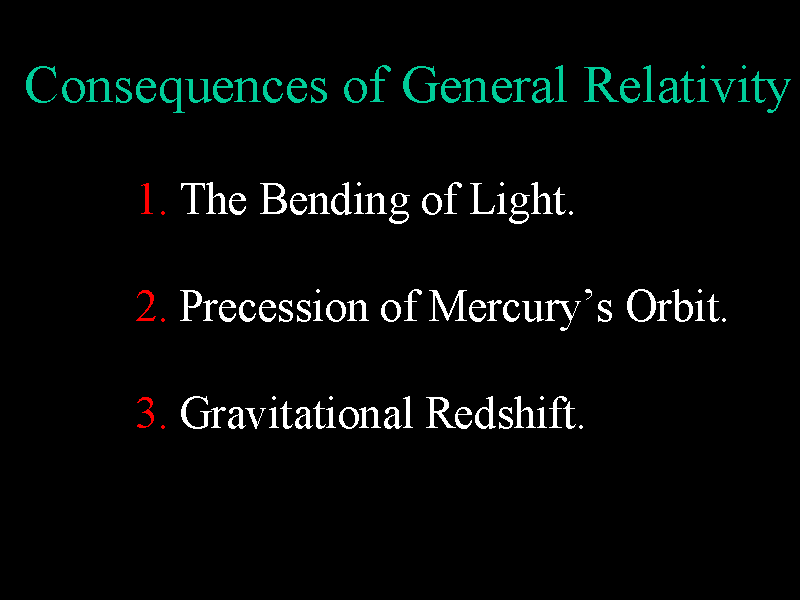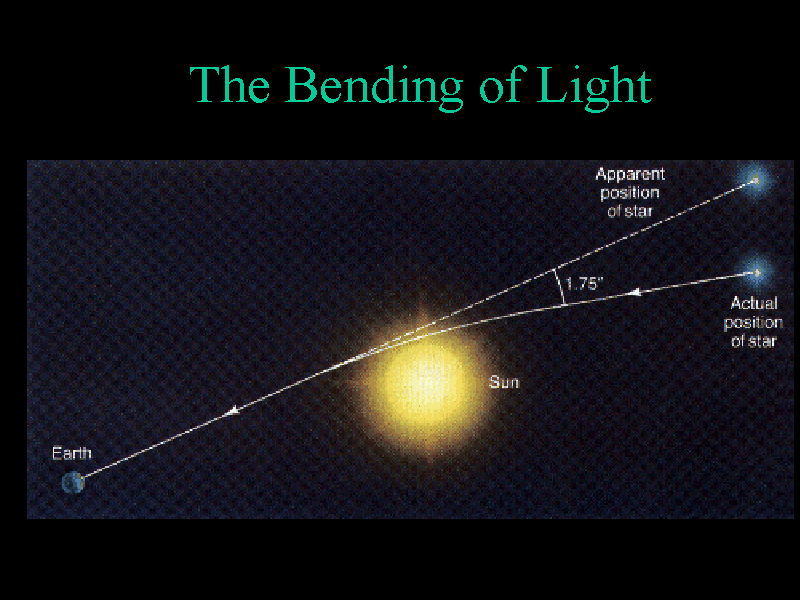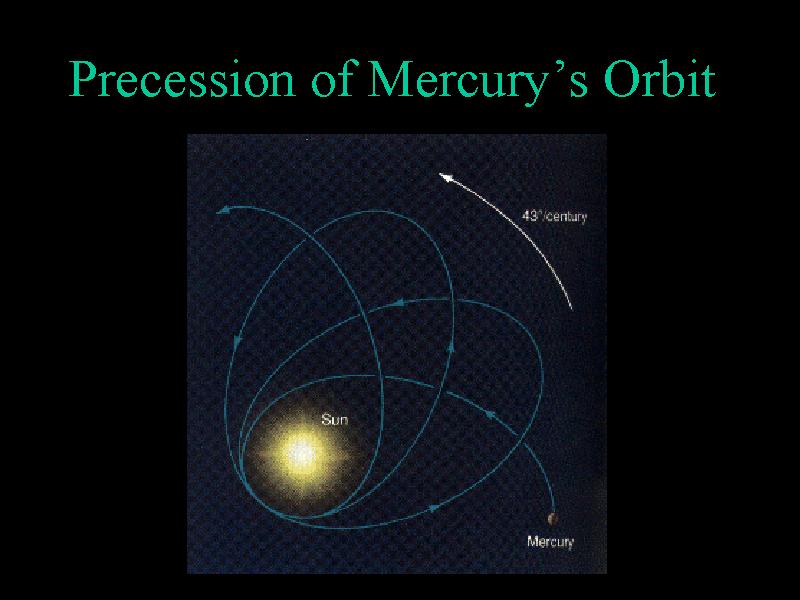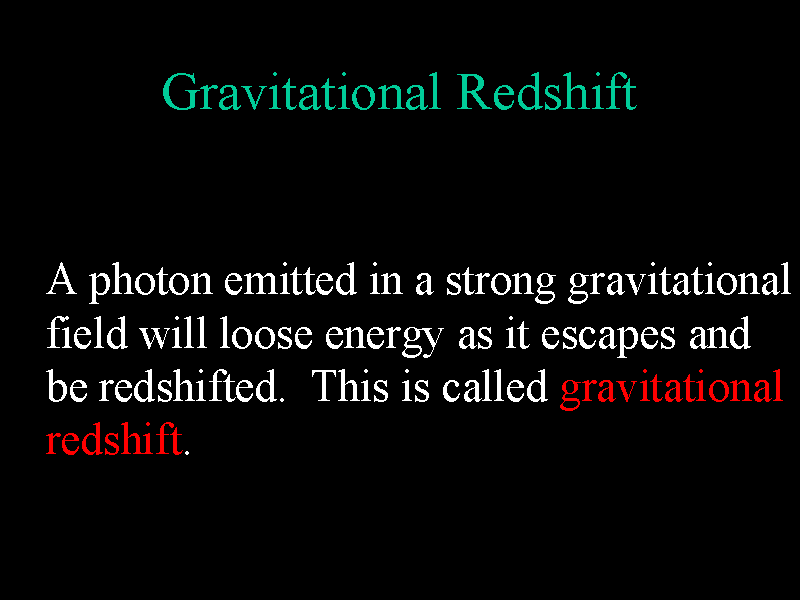Relativity and Black Holes
Consequences of General Relativity
 In his 1915 paper, Einstein pointed out 3 consequences of his theory:
In his 1915 paper, Einstein pointed out 3 consequences of his theory:
- The bending of light as it passes near a massive object,
- the precession of Mercury's orbit, and
- gravitational redshift.
 Since we postulate that gravity is a curvature of spacetime and that photons
follow geodesics in spacetime, we find that "gravity bends light" (to be
precise, it is the spacetime which is bent). The effect was experimentally
verified in the famous 1919 eclipse expedition of Arthur Eddington. During
a total eclipse of the Sun, the position of a star very near the Sun's limb
was measured. The star's position was found to be shifted by an amount
predicted by the general theory. This experiment played a big role in making
Einstein the "scientific genius" and public figure that he was to become in
the 20's, 30', and 40's.
Since we postulate that gravity is a curvature of spacetime and that photons
follow geodesics in spacetime, we find that "gravity bends light" (to be
precise, it is the spacetime which is bent). The effect was experimentally
verified in the famous 1919 eclipse expedition of Arthur Eddington. During
a total eclipse of the Sun, the position of a star very near the Sun's limb
was measured. The star's position was found to be shifted by an amount
predicted by the general theory. This experiment played a big role in making
Einstein the "scientific genius" and public figure that he was to become in
the 20's, 30', and 40's.
 A reputation that continues even today!
This experiment has been reproduced a number of times using other parts of the
electromagnetic spectrum (mainly, radio sources). A more contemporary example
which is also a consequence of this "bending of light" is gravitational
lensing.
A reputation that continues even today!
This experiment has been reproduced a number of times using other parts of the
electromagnetic spectrum (mainly, radio sources). A more contemporary example
which is also a consequence of this "bending of light" is gravitational
lensing.
 If a very distant galaxy is precisely along the line of sight with a massive
foreground object, then we will see multiple images of the background galaxy
as the foreground object "focuses" the light rays. In some situations, the
image appears curved and is a segment of the a so-called Einstein
ring.
In this Hubble Space Telescope image of the cluster of galaxies Abell 2218, we
see arcs of the Einstein ring of distant galaxies which are focused by the
Abell cluster.
If a very distant galaxy is precisely along the line of sight with a massive
foreground object, then we will see multiple images of the background galaxy
as the foreground object "focuses" the light rays. In some situations, the
image appears curved and is a segment of the a so-called Einstein
ring.
In this Hubble Space Telescope image of the cluster of galaxies Abell 2218, we
see arcs of the Einstein ring of distant galaxies which are focused by the
Abell cluster.
 Here is a Hubble image of
the cluster of galaxies C10024+1654. This impressive photo shows a number of
images of a distant blue galaxy. Notice that the images are a bit distorted
and lie along a circle roughly centered at the location of the cluster.
Here is a Hubble image of
the cluster of galaxies C10024+1654. This impressive photo shows a number of
images of a distant blue galaxy. Notice that the images are a bit distorted
and lie along a circle roughly centered at the location of the cluster.
 A second example of experimental evidence in support of the general theory of
relativity is the precession of the orbit of Mercury. Mercury orbits the Sun
in an elliptical orbit with eccentricity 0.2 and therefore experiences
different accelerations due to the Sun. This results in a precession (or
shifting) of the perihelion (the point of the orbit closest to the Sun) over
consecutive orbits. The observed precession is
43.11''± 0.45'' per century and general
relativity predicts a precession of 43.03'' per century.
A second example of experimental evidence in support of the general theory of
relativity is the precession of the orbit of Mercury. Mercury orbits the Sun
in an elliptical orbit with eccentricity 0.2 and therefore experiences
different accelerations due to the Sun. This results in a precession (or
shifting) of the perihelion (the point of the orbit closest to the Sun) over
consecutive orbits. The observed precession is
43.11''± 0.45'' per century and general
relativity predicts a precession of 43.03'' per century.
 A photon emitted near the surface of an extremely massive object will
loose energy as it escapes the intense gravitational field. This results
in a gravitational redshift of the photons. We'll explore this in
more detail when we look at black holes.
A photon emitted near the surface of an extremely massive object will
loose energy as it escapes the intense gravitational field. This results
in a gravitational redshift of the photons. We'll explore this in
more detail when we look at black holes.
Go to next section.







